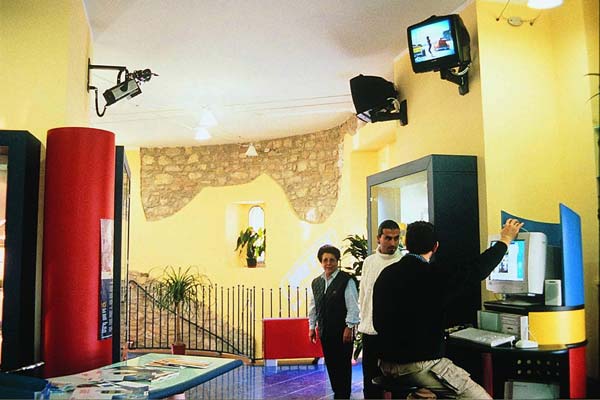To combine new with old, tradition with technology, is one of the most suggestive challenges brought forward by interior design in the last few years.
Telecom Italia Mobile is part of this research to the extent that, at the origin of each new TIM point-of-sale there is a rigorous study of the most suitable architectural and technological choices to make the shop functional, welcoming and attractive.
A TECHNOLOGICAL JEWEL INSIDE THE WALLS OF SPOLETO
The new TIM “Marconi” shop has been created inside the mediaeval walls of Spoleto, with the intention of blending classical and modern elements. Architect Nicola Grandolini, director of the “Planet G” studio, explains to us how the project was born: “The customer already had a Telecom point-of-sale in the centre of Spoleto. For this new shop he chose to work greatly on the image and to adopt certain techniques that would allow him to provide efficient information about the products and services offered. A furnishing layout was conceived for this purpose that stressed the classical-modern contrast given by blending the historical elements of the ancient walls with the play of warm colours and strongly penetrating light signals”.
The Spoleto TIM shop comprises three basic areas on two floors. The semi-basement floor houses the customer assistance service and the management offices, and is the one that more greatly retains the ancient stamp, with a brick arch covering the entrance near the access stairs to the upper floor.
The ground floor consists of two rooms, one of which is used for sales, negotiating contracts and recharging swipe-cards. The adjoining room, on the other hand, contains a rich display of portable telephones, and is typified by interesting furnishing solutions that constitute the distinctive symbol of the shop. So not only practicality and functionality, but also ergonomics, innovation and entertainment are the basis of this commercial model.
V.I.P. 300: COMMUNICATING WITH LIGHT
Among the most interesting novelties is the projection of informative and promotional light messages. A Clay Paky V.I.P. 300 DIA has been installed on the dividing wall and fitted with a three position transparency changing disc, which allows it to project the trademarks of the sector (Telecom, Motorola, TIM) onto the walls. An oscillating mirror has been added to the projector which allows the trademark to “walk” along the walls in a straight line, producing an immediate and creative message. Moreover the addition of the mirror allows such flexibility of movement that even the most hidden walls with respect to the axis of projection can be reached with remarkable ease. This is why only 1 V.I.P. is sufficient to guarantee total coverage of the whole ground floor of the shop.
The positioning of the V.I.P. 300 was carefully studied by Architect Grandolini: “The axonometry of the lighting with respect to the furnishings was conceived for the very purpose of breaking up the rigid geometry of the premises; use of the Clay Paky V.I.P. is part of this interplay of lights and proportions and, at the same time, resolves the lighting technology requirements of the environment”.
LIGHTING INFORMS AND FURNISHES WITH THE CLAY PAKY DISPLAY LINE
Consequently illumination becomes a determining element in the organisation of internal spaces, being able to integrate with or be complementary to the other furnishings present. The V.I.P. 300 DIA, which belongs to the CLAY PAKY DISPLAY LINE range of visual information projectors, performs this role perfectly, interpreting the spaces creatively and producing communication. Furthermore, the V.I.P. has two electrified guides upon which up to three accessories from among the many ones available in the catalogue can be fitted, among these is the “oscillating mirror” used in this case: this provides extreme versatility of use and the total absence of inconvenient and unsightly power supply cables.
A SHOP RICH IN IDEAS
Among the other novelties present in the TIM centre, we can find several terminals for navigating the Internet and various televisions fitted with parabolic aerials and video-recording systems for transmitting pictures of sure interest: musical videos from MTV, sporting events, soccer matches where the Italian team is playing, etc. The shop thus becomes a centre for entertainment, a “meeting place”. It is no longer enough to offer the customer a good product or a bargain: he/she must also be offered positive stimuli, welcomed, entranced and left with the desire to come back soon. Customers, both young people and the more adult, like to be “wooed”, over and above the business reason that led them to that shop. Many of the new point-of-sale promotion techniques, in fact, are aimed at encouraging the play and entertainment aspect.
In the TIM centre of Spoleto the greatest attention is paid to every detail: flooring with blue Rex Lapis quartz agglomerate tiles, porcelain-finish gres for the semi-basement, solid cherry-wood stairs to the upper floor, restored antique wooden furniture, level and stepped false ceilings to cater for the irregularities of the various corners. Particular care has also been taken over the choice of colours: red and blue paintwork typical of every TIM centre, aquamarine green glazing, blue, metallic grey and walnut display cases, pale blue laminations and electric blue painted banisters and handrails.
All this helps to create a pleasing effect, an atmosphere that is warm and not random, since it is due to the careful examination of each individual element.
TOWARDS NEW FRONTIERS OF INTERIOR DESIGN
Architect Grandolini concludes: “We wanted to offer an environment that was socially acceptable to both the young and the not so young. The shop, as well as being a ‘point-of-sale’, will increasingly become a reference and meeting point. This is why care must be taken over every detail of the interior design, from unusual furnishing solutions to the expressive capacity of colours and to the possibility of transmitting light messages using flexible, efficient lighting tools. If it is then possible to introduce these suggestive technologies into an historic or artistic context, as we have done here in Spoleto, we can say that we have obtained the maximum from interior design!”.



